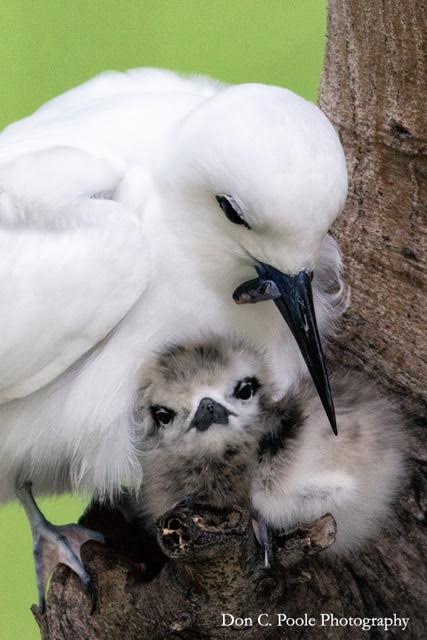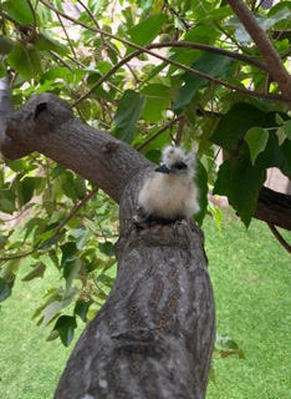|
Tucked away on Cooke Street just makai of Kapiolani Boulevard is a row of shower trees that hosts several breeding pairs of white terns. Almost any time of the year there's at least one chick there in some stage of development. On or about July 5th one more chick hatched there. This nesting spot clings to the side of the trunk of the tree and is one of those that you look at and wonder what on earth the adults were thinking when they selected it. If you've watched white terns much at all, you know that they are very deliberate in their nesting spot selection. They don't lay an egg until both parents have closely inspected and approved the spot where they will be taking turns with incubation duties for an entire month. Bad site selection can have disastrous consequences for the egg and, if it survives to hatch, the chick. However, after successfully fledging one chick here earlier this year, this pair returned to tempt fate again. For a second time since February the parents are now feeding and caring for a chick on a precarious ledge that the youngster will call home for at least the next 6 or 7 weeks. Then, when it's able to fly and to choose where it'll perch for the rest of its growing-up time, it'll probably pick another spot in the tree with a little more room to move around!
Thanks to Don Poole for this stunning photo of the newly-hatched chick being fed. Awesome shot Don! You can check out more of Don's collection of amazing white tern photos at http://hawaiishotsphotography.com/fairy-tern.html Here's the latest white tern chick arrival in The Tree at St Andrews Cathedral. It hatched January 14th and this photo was taken the next day by our team arborist (Lake Gibby) as he was tending the cameras in tree that will monitor its growth and development. The photo shows how white tern chicks, from the moment they hatch, are equipped to grip and hold on to the branch where they'll spend the first several weeks of their life. This adaptation contributes to the relatively high survival rate the tern chicks enjoy despite the precarious perches their parents often pick for nesting sites on windy Oahu.
Next to St. Andrew's Church in Downtown Honolulu, there's a Kukui tree that currently hosts six White Tern nests (GPS pt. 344). So many terns nesting in one tree is highly unusual, especially at this time of year. So many eggs and chicks in one place provides a great opportunity to observe the different parenting styles among the population of White Terns in Honolulu. Some chicks are hatched into families where the parents demonstrate a much more hands-on approach and where they experience more interaction with their parents during the days and weeks that the chick's world is confined to the branch where they were hatched. A two-week old chick in the St. Andrew's Kukui tree is one of these cases. A couple days ago, I watched as both parents returned from foraging at sea with two fish. One (likely the mother) landed first, followed immediately by the other (probably the father) with two fish in his bill. The mother took one fish from the father and carefully fed it to the chick, ensuring that it ate it head first. The mother then repeated the process with the second fish, pausing to make sure the chick had swallowed the first. It is not unusual to see this method of feeding among parents of very young chicks, where one passes the food to the other who then feeds the chick. By the time chicks are a couple weeks old, however, feeding tends to be pretty perfunctory. Not so with this little family, where the interaction between chick and parents provides one more example of what makes these birds so special. Last week’s new arrival was hatched into this world in a relatively quiet and peaceful stand of Kukui trees near the war memorial on Richards Street. White Terns like this kind of urban environment for raising their young. The surroundings for this week’s new arrival could hardly be more different. It was hatched sometime during the past week, a little more than 20 feet up in a Shower Tree at the busy intersection of Kalakaua Ave and Kalaimoku St on the Waikiki strip. From its perch this chick will have a lot of traffic to watch - pedestrian and vehicle - over the next few months. Contrary to what you would think, White Terns also like this kind of urban environment for raising their young. At least that’s what the nesting map seems to show. Kalakaua Ave, with it’s non-stop traffic is one of the most densely packed stretches of nesting trees in the entire study area. In fact, this chick joins a veritable colony of young White Terns that currently call this part of Waikiki home. Just around the corner on Kalaimoku, a juvenile (at GPS point 1015 on the nesting map) splits its time between taking practice flights around the neighborhood and perching and preening just across the street from the Ritz Carlton and Tiffany’s. Back down Kalakaua in front of the Luana Hotel (GPS point 1014), a large chick spends its days largely unnoticed by the steady flow of pedestrians passing just below the spot 14’ 10” above the sidewalk where it hatched about a month ago. And about 50 feet back up Kalakaua (GPS point 519) , on a limb hanging out over the east-bound bus lane is another chick that hatched around the first of September. They are at different stages of development but they are all part of the 2016 cohort of the growing Oahu manu-o-Kū population. Photo Credit: Rich Downs
|
Archives
February 2024
Categories |

